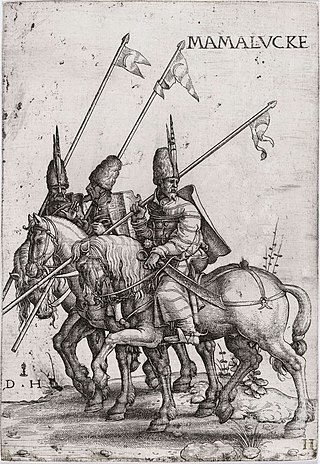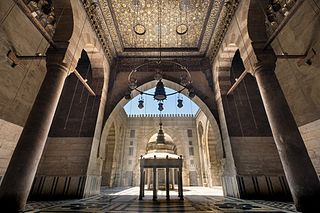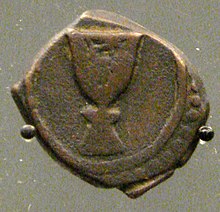
Year 1234 (MCCXXXIV) was a common year starting on Sunday of the Julian calendar.

Mamluk or Mamaluk were non-Arab, ethnically diverse enslaved mercenaries, slave-soldiers, and freed slaves who were assigned high-ranking military and administrative duties, serving the ruling Arab and Ottoman dynasties in the Muslim world.

The Ayyubid dynasty, also known as the Ayyubid Sultanate, was the founding dynasty of the medieval Sultanate of Egypt established by Saladin in 1171, following his abolition of the Fatimid Caliphate of Egypt. A Sunni Muslim of Kurdish origin, Saladin had originally served the Zengid ruler Nur ad-Din, leading Nur ad-Din's army in battle against the Crusaders in Fatimid Egypt, where he was made Vizier. Following Nur ad-Din's death, Saladin was proclaimed as the first Sultan of Egypt by the Abbasid Caliphate, and rapidly expanded the new sultanate beyond the frontiers of Egypt to encompass most of the Levant, in addition to Hijaz, Yemen, northern Nubia, Tarabulus, Cyrenaica, southern Anatolia, and northern Iraq, the homeland of his Kurdish family. By virtue of his sultanate including Hijaz, the location of the Islamic holy cities of Mecca and Medina, he was the first ruler to be hailed as the Custodian of the Two Holy Mosques, a title that would be held by all subsequent sultans of Egypt until the Ottoman conquest of 1517. Saladin's military campaigns in the first decade of his rule, aimed at uniting the various Arab and Muslim states in the region against the Crusaders, set the general borders and sphere of influence of the sultanate of Egypt for the almost three and a half centuries of its existence. Most of the Crusader states, including the Kingdom of Jerusalem, fell to Saladin after his victory at the Battle of Hattin in 1187. However, the Crusaders reconquered the coast of Palestine in the 1190s.

The Zengid or Zangid dynasty, also referred to as the Atabegate of Mosul, Aleppo and Damascus, or the Zengid State was initially an Atabegate of the Seljuk Empire created in 1127. It formed a Turkoman dynasty of Sunni Muslim faith, which ruled parts of the Levant and Upper Mesopotamia, and eventually seized control of Egypt in 1169. In 1174 the Zengid state extended from Tripoli to Hamadan and from Yemen to Sivas. Imad ad-Din Zengi was the first ruler of the dynasty.

The Bahri Mamluks, sometimes referred to as the Bahri dynasty, were the rulers of the Mamluk Sultanate of Egypt from 1250 to 1382, following the Ayyubid dynasty. The members of the Mamluk ruling class were purchased as slaves (mamluks) and manumitted, with the most powerful among them taking the role of sultan in Cairo. While several Bahri Mamluk sultans tried to establish hereditary dynasties through their sons, these attempts were ultimately unsuccessful, with the role of sultan often passing on to another powerful Mamluk.
Al-Malik as-Salih Najm al-Din Ayyub, nickname: Abu al-Futuh, also known as al-Malik al-Salih, was the Ayyubid ruler of Egypt from 1240 to 1249.

Izz al-Din Aybak was the first of the Mamluk sultans of Egypt in the Turkic Bahri line. He ruled from 1250 until his death in 1257.

Shajar al-Durr, also Shajarat al-Durr, whose royal name was al-Malika ʿAṣmat ad-Dīn ʾUmm-Khalīl Shajar ad-Durr, was a ruler of Egypt. She was the wife of As-Salih Ayyub, and later of Izz al-Din Aybak, the first sultan of the Mamluk Bahri dynasty. Prior to becoming Ayyub's wife, she was a child slave and Ayyub's concubine.

Al-Malik Az-Zahir Sayf ad-Din Barquq was the first Sultan of the Circassian Mamluk Burji dynasty of Egypt ruling from 1382 to 1389 and 1390 to 1399. Born to a Christian father in Circassia, Barquq was enslaved and later arrived in Egypt. He deposed sultan al-Salih Hajji to claim the throne for himself. Once in power, he placed many of his family members in positions of power. Rebelling governors in 1389 restored Hajji to the throne but Barquq was able to reclaim the throne shortly after and ruled until his death in 1399 and was succeeded by his son. The name Barquq is of Circassian origin and is his birth name.
Pope Athanasius III of Alexandria, 76th Pope of Alexandria and Patriarch of the See of St. Mark.

The Eretnids were a dynasty that ruled a state spanning central and eastern Anatolia from 1335 to 1381. The dynasty's founder, Eretna, was an Ilkhanid officer of Uyghur origin, under Timurtash, who was appointed as the governor of Anatolia. Some time after the latter's downfall, Eretna became the governor under the suzerainty of the Jalayirid ruler Hasan Buzurg. After an unexpected victory at the Battle of Karanbük, against Mongol warlords competing to restore the Ilkhanate, Eretna claimed independence declaring himself the sultan of his domains. His reign was largely prosperous earning him the nickname Köse Peyghamber.

Al-Ashraf Sayf ad-Dīn Barsbāy was the ninth Burji Mamluk sultan of Egypt from AD 1422 to 1438. He was Circassian by birth and a former slave of the first Burji Sultan, Barquq.
Regencies in Egypt date back to Pharaonic times. Throughout Egypt's long history, there have been several instances of regents assuming power due to the reigning monarch's minority, physical illness or poor mental health. There have also been several cases of coregencies where two monarchs ruled simultaneously.

Al-Kamil Sayf ad-Din Sha'ban ibn Muhammad ibn Qalawun, better known as al-Kamil Sha'ban, was the Mamluk sultan of Egypt between August 1345 and January 1346. He was the fifth son of al-Nasir Muhammad to serve as sultan, having succeeded his brother al-Salih Ismail. Sha'ban was toppled and killed during a revolt against his rule organized by Emir Shams ad-Din Aqsunqur on behalf of his brother al-Muzaffar Hajji.
Sayf ad-Din Baybugha Rus al-Qasimi an-Nasiri was a prominent Mamluk emir during the reigns of sultans as-Salih Isma'il, al-Muzaffar Hajji, an-Nasir Hasan and as-Salih Salih.

Al-Mansur Ala' ad-Din Ali ibn Sha'ban ibn Husayn ibn Muhammad ibn Qalawun, better known as al-Mansur Ali II, was the Mamluk sultan reigning in 1377–1381. He was installed to the throne while a child by the senior Mamluk emirs after they had rebelled against and killed al-Mansur Ali's father, Sultan al-Ashraf Sha'ban. Al-Mansur Ali was a figurehead, with real power being held by the senior emirs, most prominently Barquq. Al-Mansur Ali died about four years into his reign and was succeeded by his younger brother, as-Salih Hajji, although real power was still held by Barquq, who usurped the throne in 1382.
The Buhturids or the Tanukh were a dynasty whose chiefs were the emirs of the Gharb area southeast of Beirut in Mount Lebanon in the 12th–15th centuries. A family of the Tanukhid tribal confederation, they were established in the Gharb by the Muslim atabegs of Damascus after the capture of Beirut by the Crusaders in 1110. They were tasked with guarding the mountainous frontier between the Crusader coastlands and the Islamic interior of the Levant. They were granted iqtas over villages in the Gharb and command over its peasant warriors, who subscribed to the Druze religion, which the Buhturids followed. Their iqtas were successively confirmed, decreased or increased by the Burid, Zengid, Ayyubid and Mamluk rulers of Damascus in return for military service and intelligence gathering in the war with the Crusader lordships of Beirut and Sidon. In times of peace the Buhturids maintained working relations with the Crusaders.

The Mausoleum of Shajar al-Durr is a mausoleum housing the tomb of the female Ayyubid sultan Shajar al-Durr in Cairo, Egypt. It is located on al-Khalifa Street or Shurafa Street, in a neighbourhood on the edge of the al-Qarafa cemeteries. Its construction was commissioned by Shajar al-Durr herself and it is believed to have been built in the Islamic year 648 AH. Shajar al-Durr was notable for being the only female Muslim ruler in Egyptian history and for playing a crucial role in the transition from Ayyubid rule to Mamluk rule. The mausoleum serves as the formal resting place of the queen and commemorates her legacy. Architectural features of this structure, along with the broader architectural patronage of Shajar al-Durr, influenced future Mamluk architecture.















